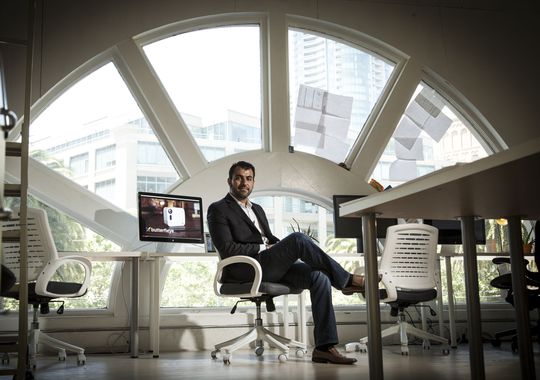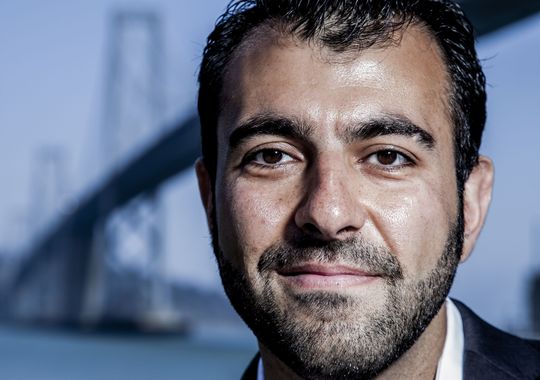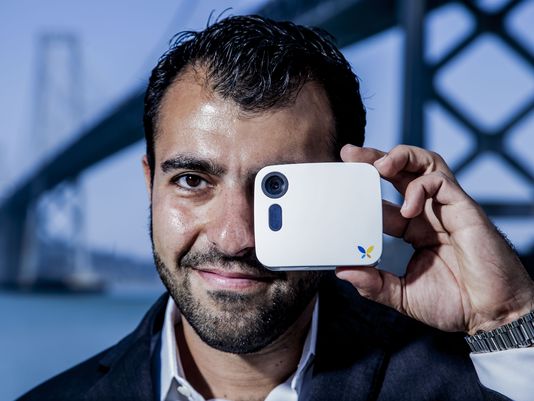Change Agents: Butterfleye flies into smart-home hive
HTTP/1.1 200 OK Server: nginx/1.2.7 Content-Type: text/html; charset=utf-8 Content-Language: en Last-Modified: Tue, 24 Jun 2014 15:33:47 GMT X-UA-Compatible: IE=Edge,chrome=1 X-Secret: cnpudnkgcnpiZXZnbUBoZm5nYnFubC5wYnogbmFxIFYganZ5eSBnZWwgZ2IgdHJnIGxiaCBuIHdiby4= Cache-Control: max-age=20 Expires: Tue, 24 Jun 2014 15:37:06 GMT Date: Tue, 24 Jun 2014 15:36:46 GMT Transfer-Encoding: chunked Connection: keep-alive Connection: Transfer-Encoding
SAN FRANCISCO — Ben Nader's tech brainstorm came courtesy of a thief. Make that several thieves.
After a succession of apartment break-ins, each resulting in the disappearance of his prized bicycles, Nader, 30, an engineer by training, set about installing a home security system.
"Here I'm the tech-savvy guy who worked with camera chips and sensors (at Texas Instruments), and it still took me three days to set it up — drilling holes, running wire and fiddling with router settings," he says. "I thought, 'There has to be a better way.' "
Nader's better way is called Butterfleye[1], a year-old start-up now taking online pre-orders for its wireless, high-quality optics camera that aims to do far more than just keep an eye on your home. It wants to be your personal videographer, too.
The $250 device ($199 if pre-ordered, and less if purchased in a home-pack trio) features what Nader calls Active Eye Intelligence. This face-detection algorithm marks when faces are logged into the sharp 1980p by 1080p video stream, making it easier to scroll back through the day's time line and look for prized moments. Nader and his team of five hope to soon make that feature face-recognizing, meaning faces in your contacts lists will be tagged by name.
"Cameras are dumb; they're just streaming video to the cloud. So the question is, can you make your camera intelligent? The answer is yes," he says. "It should know when it's you at home, and know not to record you unless you tell it to. Or if it's your pet wandering through the house, you shouldn't get an alert about that."
That camera-with-a-brain twist tweaks Butterfleye from passive security guard to smart assistant, something that Nader says distinguishes his creation from main market competitor, Dropcam, which last week was snapped up by Google in a $555 million deal. Nader likes to call Butterfleye "Dropcam meets Nest," the latter being Google's recently purchased learning-thermostat company.
Although his biggest foe just got the muscle of Google behind it, Nader isn't flinching.
"This is just the beginning of us being part of the smart and connected home," he says. "Maybe (Butterfleye's) initial appeal is as an easy-to-use security camera, or perhaps as a personal videographer. But as image recognition improves, the possibilities are endless. The window is open? It will alert you. The coffee pot is still on, but it knows you left the house and pings you."
Nader admits that all-seeing eyes come with built-in privacy concerns. While he can't control every aspect of Butterfleye's eventual use, the product does have a feature that asks authorized users currently in a home — via a smartphone alert — if an authorized user outside can monitor the action.
"I don't want to encourage the negative side ... 'Oh, I want to check what my wife is doing,' " he says. "But I suppose ultimately, people will use this in different ways."

Ben Nader is photographed at his San Francisco waterfront office on June 6.(Photo: Martin E. Klimek, USA TODAY)
The good news for Nader is he's diving into a hot market segment, as evidenced by Google's smart-home buying spree, as well as Apple's recent announcement of its HomeKit API, which allows developers working on smart-home products to integrate them with Apple's iOS operating system.
But that's also the bad news, as a growing number of big players — ranging from AT&T to Honeywell — race into this inevitably lucrative space, says Avi Greengart, market analyst with Current Analysis.
"The Dropcam and Nests of the world are already disrupting the big players with simple-to-install products, so the whole area is ripe for new ideas and consolidation," says Greengart. "There are lots of companies entering the time-lapse camera market, with pros and cons. How well they really integrate into the home will be critical."
Butterfleye investor Peter Relan thinks Nader has what it takes to crack the code.
"At every turn, he's listened to suggestions and pivoted when needed, and that's rare; an engineer who really can think beyond that and into the marketing," says Relan, chief mentor at Studio9Plus, an incubator that chooses roughly a half-dozen promising start-ups a year to seed with funds and advice for nine months each.
"Dropcam is to (in-home) cameras what the first phone with features was to the original cellphone," he says. "Using that analogy, I told Ben, 'Butterfleye needs to be the first smartphone of security cameras. If you focus on making your camera intelligent, then I'm interested.' "
Nader is unfailingly polite and gregarious, but one detects an unrelenting drive beneath that calm exterior.
Relan, the former chief technology officer of early dot-com delivery service WebVan, saw it first hand when he was delicately prodded into speeding up some Butterfleye analysis. "Ben very politely said he would show up at my house to get the feedback, on a Sunday," he laughs. "But you have to like that."
Credit some of that dedication to a tumultuous youth. He was born in Tehran, where he discovered a youthful passion "for tinkering with any toy that had motors and parts and lights." After Nader's father passed away, his mother emigrated to Portland, Ore., with her two sons.
"I was in 10th grade and didn't speak much English, and you know how cliquish high school can be if you're not exactly from around town," says Nader in slightly accented English. "But it was all good. I learned a lot. I deep-dived into things, from English to math and science. I immediately got a sense you could really pursue your dreams in America."
Specifically, Nader became fixated on applying his math aptitude toward building products that could help improve lives. "In my mind was always this sense that technology for technology's sake isn't good enough," he says. "The question is, can you build something that is useful to someone?"
After graduating from Oregon State in five years (he took one year off to intern at Intel) he moved to the Bay Area to join semiconductor maker Maxim Integrated Products. Soon after, he went to Texas Instruments, and as a product manager, traveled the world selling chips that brought cameras to life.
Then came his stolen bicycles and the conviction that he had his own mark to make on the consumer product world. Little surprise that one of the first people to place a pre-order on his website was his mother.
"Yes, I think she is very pleased," Nader says softly. "It is perhaps more than what she could have imagined for me."

Ben Nader.(Photo: Martin E. Klimek, USA TODAY)
ABOUT BEN NADER, 30
What: Founder, Butterfleye, wireless in-home video camera
Where: San Francisco
How did you get the electronics bug? "When I was a little kid growing up in Tehran, a highlight was going to these small shops that sold electronic kits you'd make at home. One memory I have with my (late) father was a simple plug-and-play kit where in the end, an LED light went on. But that was it for me."
What was a formative moment in your early career? "Taking a year off of college (to intern at Intel). I was nervous because all my friends were graduating in four years. But it was one of the best decisions ever. It took me from the theory of school to real-world applications of engineering and math."
Why did you think consumers would want Butterfleye? "Before I quit my job (at Texas Instruments) to start the company, I went to big-box electronics stores and with the managers' OK, just talked to people. Most weren't looking for a home security thing where you have a keypad and a monthly fee. In fact, my friends who have those elaborate systems all told me they never bother to set their alarms. So I knew there was a possibility of creating a new product."
USA TODAY's Change Agents series highlights innovators and entrepreneurs looking to change business and culture with their vision. E-mail Marco della Cava at This email address is being protected from spambots. You need JavaScript enabled to view it.. Follow him on Twitter:@marcodellacava.
Read or Share this story: http://usat.ly/1iAxgKB
References
- ^ http://preorder.getbutterfleye.com/ (preorder.getbutterfleye.com)










